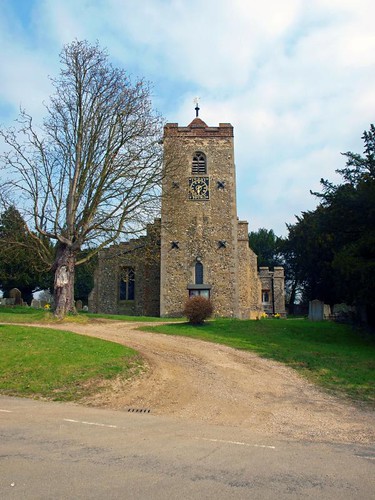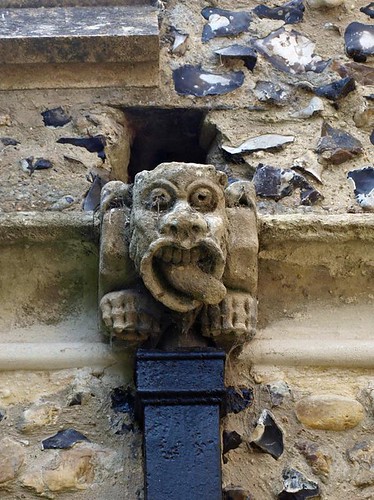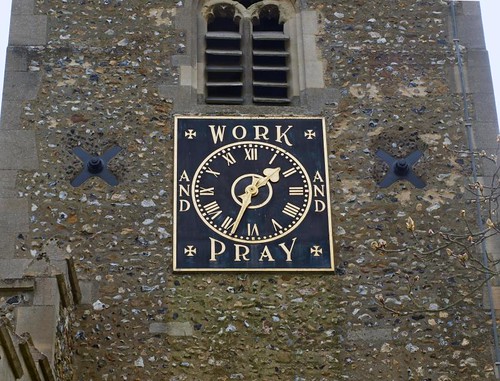Annoyingly I missed the C14th glass in the chancel window tracery having written it off after a cursory glance at the main Victorian bog standard window - another lesson learnt perhaps.
ST MARY THE VIRGIN. Norman nave, see the NW quoin strengthened with Roman bricks, and some fragments of diapering loose inside the church. Unbuttressed W tower of the C13, completed or restored and embattled in the C16 in brick. The rest Early Perp, including the five-light E window. - STAINED GLASS. In the head of this window a complete Coronation of the Virgin with two censing angels and eight orders of angels, late C14 and well preserved. - PLATE. Cup with band of ornament, 1561; Paten probably also 1561.
SHEERING. Its cottages line the road from Harlow to Hatfield’s broad common, but the church stands down a lane behind three huge chestnuts which shade the remains of the whipping-post. It is 14th century, famed for its rare and beautiful glass, and has been lovingly restored and its ancient treasures safeguarded. The tower is 650 years old, and on each side of its arch indoors is a smaller arch forming an arcade at the end of the nave, There is a priest’s room over the porch, and in the vestry is a window through which he would watch the altar. He must have been proud of his lovely door and doorway into the chancel, both remaining in all their beauty after five or six centuries. The door has a narrow border of quatrefoils and beads, and the ironwork is shaped into fleur-de-lys for hinges. Original, too, is the woodwork of the doors of the nave, held together by wooden pegs.
The window over the altar was long ago a treasury of glass, and much of it remains. The figures in the tracery are where they were when the chancel was built, revealing to us the eight orders of the Heavenly Host, whose names every monk knew, though they are here set down. Above them is the Madonna, having just received her crown from the enthroned Christ, two attendant angels swinging enormous censers. With their glowing colour and their simple dignity these portraits are among the best in any window in Essex.
Behind a glass frame is another example of medieval colour, a consecration cross with flowered ends, drawn in a red circle on the wall. Still here are fragments of the Norman font, and a stall on which were carved 500 years ago the heads of a king, a queen, and two knights in their helmets. Lost for centuries and found under the straw in a neighbouring barn, this stall is now back in the chancel*.
The window over the altar was long ago a treasury of glass, and much of it remains. The figures in the tracery are where they were when the chancel was built, revealing to us the eight orders of the Heavenly Host, whose names every monk knew, though they are here set down. Above them is the Madonna, having just received her crown from the enthroned Christ, two attendant angels swinging enormous censers. With their glowing colour and their simple dignity these portraits are among the best in any window in Essex.
Behind a glass frame is another example of medieval colour, a consecration cross with flowered ends, drawn in a red circle on the wall. Still here are fragments of the Norman font, and a stall on which were carved 500 years ago the heads of a king, a queen, and two knights in their helmets. Lost for centuries and found under the straw in a neighbouring barn, this stall is now back in the chancel*.
* either I missed this stall as well as the glass or it's no longer extant (looking at the nave/chancel pictures I think the latter).




No comments:
Post a Comment